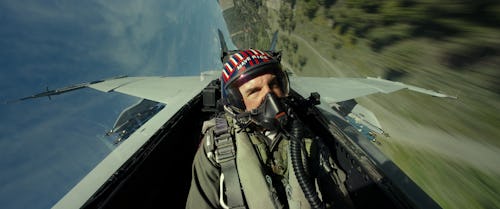
Paramount Pictures could have released Top Gun: Maverick, the highly anticipated sequel to the 1986 aviation action movie starring Tom Cruise as hotshot pilot Pete “Maverick” Mitchell, on Paramount+ a year ago to gin up subscriptions for the newly launched streaming service.
But I’m so glad the movie studio didn’t go that route.
Maverick is a movie that would be wasted on an iPad, smartphone, laptop, or TV screen. Watching Maverick on any screen that’s not larger than your peripheral vision and with any sound system that is less than wall-and-seat-rattling Dolby Vision and Atmos sound simply won’t put you at the edge of your seat.
“This is a movie that is designed to be seen on the biggest screen you can find and the best sound system in your town,” Maverick director Joseph Kosinski (of Tron: Legacy and Oblivion fame), told me in a phone interview. “This is a reason to go to the movies and that's what we designed it for, and we're just thrilled that people are ready to go back.”
“This is a movie that is designed to be seen on the biggest screen you can find and the best sound system in your town.”
I couldn't agree more with Kosinski. While Claudio Miranda’s cinematography masterfully captures the thrill and danger of piloting fighter jets at blistering speeds — the just-over-two-hour film is a nonstop octane-fueled joyride for your eyes — Maverick's sound engineering, produced using Dolby Atmos, for Hans Zimmer and Harold Faltermeyer's soundtrack, is ultimately what will take your breath away.
It’s always a massive challenge to bring to life a sequel for an iconic movie, but Kosinski nails Maverick for the most part (about two-thirds into the movie, it kinda turns into Mission Impossible but that’s all I’m saying about that). Maverick draws on just enough nostalgia from the original Top Gun — be it dialogue or music selection — but never overdoes it.
There's plenty of dramatic flare to remind you that this is a new film, set 30-something years later, but that it's also new and mastered with the latest audio-visual technology that was not capable decades ago. The result is Maverick feels like a believable sequel to the original through its sound. Hearing the distinct thrusts of the engines, or the afterburners, or the missiles drifting between speakers all around you in a Dolby Cinema is so crucial to heightening the realism of flying multi-million-dollar jets on screen.
Prior to watching Maverick in an Atmos-tuned theater equipped with 36 surround sound speakers, I rewatched the original Top Gun on Netflix on an M1 iPad Pro. Even with head-tracking creating a simulated wide-stage listening experience (but not spatial audio) with AirPods Pro, Top Gun sounds comparatively flat versus Maverick. That's not a fair comparison, you say! (My response to that is: Yes, but it is how many people today will watch the movie — streaming on a non-surround sound device.) Okay, I also bought the 4K Blu-ray after watching Maverick and pumped the remastered Atmos-ready audio through my Sonos Arc soundbar; it's a more accurate representation of what most people would get in an Atmos-ready home theater. But Maverick's sound design doesn't make the action more convincing because it's available in Atmos, but because it was engineered for it from the start of production.
Go for the sound

Despite endless troves of director’s commentaries and behind-the-scenes extras extolling the importance of sound design to a movie’s cinematography, moviegoers largely go to theaters to get a visual experience. We decide on standard, IMAX, or 3D (whatever’s left of the format) screens; we pay more per ticket to get the immersion of a larger screen or one that displays images that pop out. Most moviegoers do not choose movies to watch for the sound — no matter how visceral it may be.
That’s changing. As streaming and COVID have chipped away at reasons to go to the cinema — the convenience of beaming a movie to your device of choice is hard to beat — movie theaters have been cornered into providing a cinema experience that truly can't be had at home. Dolby, in particular, has been leading this charge with Dolby Cinemas offered at select AMC theaters.
Blow you away with thundering Atmos sound that rains from speakers.
The idea is simple: Blow you away with thundering Atmos sound that rains from speakers positioned around, above, and behind you, and Vision picture that’s calibrated to bring you HDR image quality and resolution, color, and contrast that keeps you glued to the big screen.
Similar to IMAX, Dolby Vision at Dolby Cinema theaters is an extraordinary visual experience. Regular moviegoers might not immediately see the benefits of Vision — blacks are deeper, there’s more dynamic range, and the picture is brighter and the contrast ratio is higher thanks to more advanced projector systems — but techies and real film nerds will appreciate it.
For example, the Dolby Cinema-grade theater I watched Maverick in used dual 4K and 2K projectors to project the best image quality. A Dolby technician explained to me that most standard non-Dolby Cinema theaters use a single 4K or 2K projector; most IMAX uses dual 2K (though new ones are switching to dual 4K projector). All of this is nerd speak for: Dolby Vision at a Dolby Cinema is stunning — once you see the higher fidelity it’s hard to watch movies in a regular theater. It’s like going OLED on a phone or TV; you see the inferiority of LCD and it will bother you forever.
It’s the same thing for experiencing a movie with Dolby Atmos. We’ve detailed in depth what Atmos is, where it exists today in the entertainment world (both at home and in theaters), and where Dolby is taking it (live music, gaming, auto, and more). Just like Vision, Atmos in a Dolby Cinema is next-level. Unlike a traditional theater with multi-channel surround sound speakers that are limited by the number of speakers, Atmos allows sound designers to create a virtual bubble where sound can be placed anywhere within it to heighten audio immersion.
“[Hans Zimmer] has reached the point now where he now thinks more about Atmos and composes with Atmos in mind, and he now wants to deliver a more immersive music field that he can then hand off to [a movie's] re-recording mixes,” Stuart Bowling, Dolby's director of content and creative relations, tells me. In his role, Bowling has worked with filmmakers like Kosinski to help them get the most out of Atmos and Vision during production. Kosinski, he says, has been working with Atmos since right after Tron: Legacy was released in 2012. It wasn't until Oblivion, that the director really started thinking about movies with Atmos' capabilities.
Making audio magic
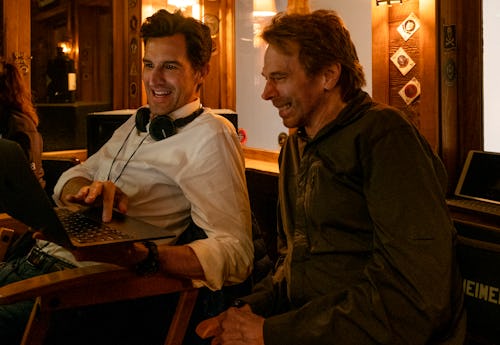
While the producers for Maverick had Atmos’s versatile digital 3D mixing in mind while filming, like any movie, sound design has its challenges, especially when you're trying to pay homage to the movie that came before it and still make something fresh.
“The great thing about our film is that we had Chris Lebenzon, one of the first editors on the first film, who came on board and worked with us for a few months on Maverick as well,” says Kosinski.
“One of the insights he gave us into the sound design for the first film was that since they were cutting on film they were splicing the hard cuts that resulted from the film splices of cutting the aerial footage together.” Kosinski says Lebenzon had left all the hard splices just like the rough cut had to achieve "Top Gun's signature hard-punching sound on the cuts.”
This “secret” from Lebenzon was carried through for Maverick. “Once Chris told us that kind of secret insight, we started applying that same principle throughout our film, by making sure that we were emphasizing every cut with a real punch in the gut low-end piece.”
And metaphorically punch you in the gut the low-end does in an Atmos theater. There are so many sequences where the sound really makes the scene — something that might be less easy to listen for in a regular theater where the sound is sure to be loud, but not as distinctly clear.
Without spoiling anything, Kosinski told me one of the earlier scenes where Maverick is piloting the hypersonic Darkstar jet — a fictional jet that is allegedly based on the reportedly-in-development SR-72 and that was designed with Lockheed Martin's Skunk Works division, the aircraft manufacturer behind the supersonic engine in the real SR-71 Blackbird — was a mix of real sounds recorded from aircraft and others mixed together.
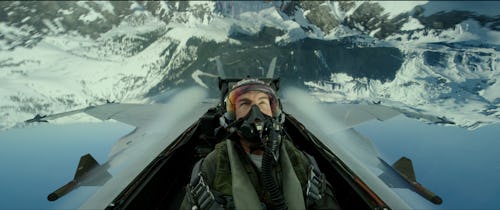
“Obviously, [the SR-72 is] a plane that doesn't exist. Well, it may exist but we couldn't record it. So [the Darkstar scene] was more of a sound design sequence to imagine what a scramjet or a combined cycle engine sounds like even though we had no access to one. That was more of having to create from scratch, but using a lot of real jet sounds to mix them in a way to create something that sounds totally new.”
But because the SR-72 is not real (not publicly as far as anyone outside of Lockheed Martin/Skunk Works know), the Darkstar's sound “was not something they could help us with so we had to kind of make that up on our own” says Kosinski.
Another scene that non-aviation moviegoers might not realize is that it's really quiet inside of a jet so cleverly mixing audio to maintain a sense of drama and risk was important.
“You're kind of using the exterior sounds of the jet to tell a story that's played a lot on the interior.”
“When you're flying a jet, truthfully it's very, very quiet. The pilot doesn't hear the afterburner or the vapes and all that stuff. That's more of a product of being on the outside of the jet,” says Kosinski. “You're kind of using the sound to tell the story of how intense the flying was because the forces were obviously, massive and what Tom did in that [low-level flyby] sequence was something that no one's ever done on film before — [flying] below 50 feet, [at] 500 miles per hour.”
“The microphones in the cockpit just don't give you much. So you're kind of using the exterior sounds of the jet to tell a story that's played a lot on the interior so that certainly was tricky.”
Bowling echoed Kosinski's sound design techniques. “One of the biggest strengths of Atmos, beyond making things seem bigger and more powerful, is its subtlety,” he says.
“You probably noticed in the film where we have like the F/A-18s off in the distance. You can really hear and track audibly where they are in space as they're flying around and it's stuff like that that's really cool for the audience. You feel like you're there, like you're in the middle of this thing that's happening because all of these additional sounds and positions and movements are really reinforcing that to the audience.”
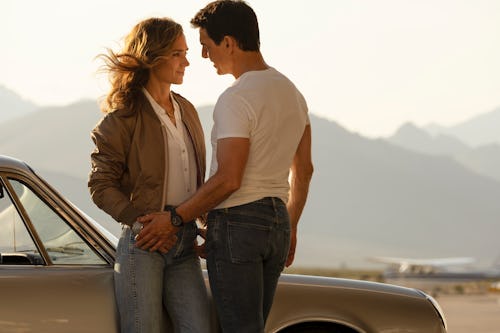
And then there's the opening, which will be familiar to anyone who's seen the 1986 movie.
“I wanted people at the beginning of the film to understand that it is a Top Gun movie. So, using the [“Top Gun Anthem” by Harold Faltermeyer] at the beginning was important and giving people “Danger Zone” [rerecorded by Kenny Loggins] on the carrier just felt like the right anthem for showing the audience what these men and women do on these carriers. It really sets you in the world of Top Gun right from the start.”
Making a sequel is a balancing act. Lean too hard into nostalgia and fans will accuse it for being lazy or excessive fanservice; go too fresh and the vibe might be too off to nail the atmosphere. “Everything is hard on a Top Gun movie,” says Kosinski.
“You need to mix the old and the new,” the director tells me. “You get into Hans [Zimmer] taking the ‘Danger Zone’ theme and turning it into an orchestral theme. He's taken the [Lady] Gaga theme [“Hold My Hand”] and uses it as a love theme through the movie. We got a mix of old tracks on the jukebox in the bar to new tracks like Ryan Tedders' new track for the beach football scene. Just like the movie has characters from the past and new characters, we wanted the soundtrack to also reflect where Maverick's come from but where he's going as well. It was important to have that balance.”
Next-gen cinema
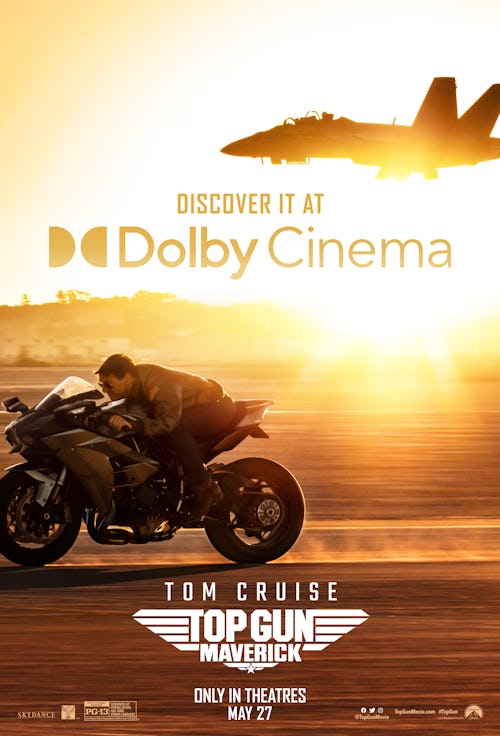
Movies will always be a visual medium first. But the best movies, the most memorable movies usually pay special attention to the sound. Close your eyes and think about how many of your favorite movies you can recognize from the sound or music selection alone. Star Wars, The Godfather, The Lion King all come to my mind. And, of course, Top Gun. Harold Faltermeyer's music for the original film is unforgettable — truly half the reason people remember it.
Watching Top Gun: Maverick at a Dolby Cinema, optimized with Vision and Atmos, is arguably the best way to experience the movie when it hits theaters on May 27. Your jaw will drop at the F/A-18 Super Hornets buzzing by and the performances from Tom Cruise, Jon Hamm, Miles Teller, Monica Barbaro, Jennifer Connelly, Glen Powell, and the rest of the cast will have you hooked from the jump, but I'm telling you Dolby's incredible Atmos sound is what had me literally shaking (in a good way) during and after the movie.
I'm sure a regular theater's surround sound speaker system is fine — loud and with the bass turned all the way up to bring the boom to the room. But if you’re going to watch Maverick — I can’t recommend it enough — the Dolby Cinema experience is worth the extra ticket price. Maverick is so much more immersive because of it.







